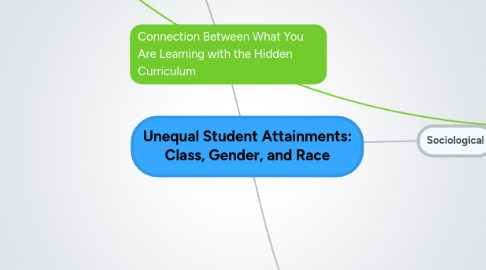
1. Philosophical
1.1. What You Are Learning
1.1.1. Dramatic changes in the fields of studies have caused differences between genders where feminine and masculine differences have caused variation between the norms. Improvement in women's participation in engineering and forestry should grow and boys should improve their reading skills
1.1.1.1. In the past, women institutes used to educate women on "homemaking", mechanic institutes were information on skills especially "mechanics" and frontier college created the labourer-teacher for railways (Spencer, 2006)
1.1.1.1.1. 3.4 % of women are in the trades programs like building, construction, and electricity. Only 22% of women graduated from engineering and architecture.
1.2. Factors that affect Student Achievement
1.2.1. Unequal high school outcomes between other schools based on resources and school quality
1.2.1.1. Public schooling is becoming more of a private system - increase in private enrollments, the entry of business into classrooms, and that education system is increasing transfer of costs to individuals and families. (Kachur & Harrison )
1.2.1.1.1. Universities and colleges are increasing tuition prices and raising the GPA which causes differences in high school systems and teaching to have more of a role in if students can get into school and changes if students from lower-income families can get into school
1.2.2. Family background - their parental socio-economic status, parental education, job status, and income. Children of low income families have less support to continue into further education, compared to those whose parents will fund and support their post secondary work
1.2.2.1. The welfare state has caused a decline in living standards, stagnant, slow growth, and increased unemployment (Kachur & Harrison )
1.2.2.1.1. Family income and family stress because of their income effects their children and their relationship throughout their lifetime including their achievement in school, social achievement, and also their future.
1.3. Gender Differences in Schools
1.3.1. Traditional jobs for both men and women are developing into being equal opportunity for both genders to participate.
1.3.1.1. The variation in sex ratios of teachers is associated with variation in other characteristics of districts like the size of their school systems and their ethnic competition (Sager, 2012)
1.3.1.1.1. Higher education has increased women's position in society from stay-at-home to successful professionals. Women make up a majority of the workforce (51% in the United States)
2. Sociological
2.1. structural functionalist
2.1.1. Decrease social class differences and give opportunity to the lower class to succeed through equal opportunities
2.1.1.1. Less affluent and ethic minorities are also more likely to affiliate themselves with drugs and have bad work habits due to lower expectations by both teachers, peers, and their families.
2.1.1.2. Data suggests this theory to be untrue: youth living in low income families are four times more likely to have impaired vocabulary development, many youth remain disadvantaged.
2.2. symbolic interaction
2.2.1. "Hidden Curriculum", educators may discriminate without really meaning to through ignorance and racial stereotyping. (Ghosh, 2008)
2.2.2. Mead's Theory, children learn the "rules of the game" and how to behave through significant others and social systems. (Barakett & Cleghorn, 2007)
2.2.2.1. Without proper socialization as a child, children can be judged by peers and mentors and streamed into disadvantaged groups from very early on, which can affect the rest of their schooling.
2.2.2.1.1. After family and close relatives and friends, schools and teachers are the main influences on childrens' lives, and they teach children morals, ethical values, and social norms through forms of hidden curriculums.
2.2.2.1.2. My family placed great importance on academics, and we were read to every night and exposed to a wide range of social situations, so my sisters and I were more likely to be categorized as "good students"
2.3. conflict theory
2.3.1. Neo-marxists believe that schools actually regenerate inequality not just in class, but in ethnic minorities and females as well through stereotyping, devaluing disadvantaged youths' cultures, skills, and placing them into lower stream classes
2.3.1.1. As teachers, it is important not to discriminate or stereotype based on social class, gender, or race. This will help close some of the social gaps in our education system.
3. Historical
3.1. Canadian School Systems
3.1.1. Those with the most education and who monopolized the school systems were Canadians of British origin with Aboriginal students at the least amount
3.1.1.1. British Columbia's private schools adopted their religious and substance of their British counterparts (Barman, 1984)
3.1.1.1.1. English and French colonized Canada in the 1700's causing Great Britain to be the founders of Canada and caused the British Parliament to take control of Canada with it's systems
3.2. Racism and Ethnic Minoritise in Canada
3.2.1. Canadians were known as two different groups: ethnic and white minorities, which caused inequality throughout many systems including work and education
3.2.1.1. Canadians have a long known history of racism towards different ethnicities including Aboriginals, and Japanese which caused inequalities throughout Canada and affected Canada today (Ghosh, 2008)
3.2.1.1.1. Inequalities and racism are still seen throughout Canadian society today as curriculum is still not fully based around Aboriginal studies or international students relate their culture to the curriculum. Some teachers are also still biased towards past events because of their beliefs and values which effect what students are taught.
3.3. Female educational attainment
3.3.1. Females were meant to stay at home or take jobs that were required with more of a "nurturting" position and men and women have different work capacties
3.3.1.1. Because of women moving into the occupation of teaching, this movement was also towards a movement of material independence, intellectual self-realization, and social respectability (Sager, 2012)
3.3.1.1.1. The women's suffrage movement achieved Women's Right to vote in the 1920's, which caused great change in women's standing in general and continues to move forward to this day
